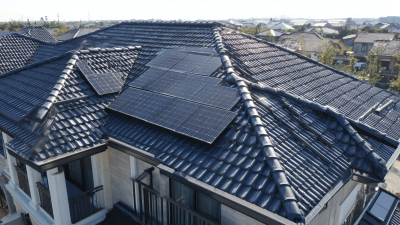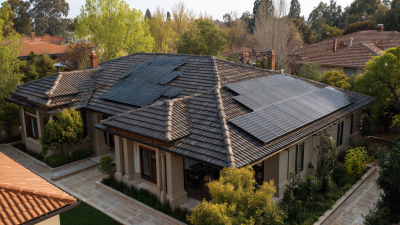How to Maximize Energy Efficiency with PV Tiles: Insights and Innovations in Solar Technology
As the world continues to seek sustainable solutions to combat climate change and reduce energy consumption, photovoltaic (PV) tiles are emerging as a groundbreaking innovation in solar technology. These sleek, aesthetically pleasing tiles not only blend seamlessly into architectural designs but also harness solar energy efficiently. By maximizing energy efficiency with PV tiles, homeowners and businesses can significantly reduce their carbon footprint while enjoying the benefits of renewable energy. This blog explores the latest insights and advancements in PV tile technology, highlighting how these innovative solutions are revolutionizing the way we think about energy generation and building design. With the potential to transform rooftops into power-generating surfaces, PV tiles represent the future of sustainable energy, paving the way for a greener, more energy-efficient world.

Understanding PV Tiles: What They Are and How They Work
Photovoltaic (PV) tiles represent a cutting-edge innovation in solar technology, designed to seamlessly integrate into building structures. Unlike traditional solar panels, PV tiles are aesthetically pleasing and can be incorporated into roofs and facades without compromising architectural integrity. They function by converting sunlight directly into electricity, utilizing the same photovoltaic principles found in standard solar technologies. This integration allows for efficient energy generation right where it is consumed, thus minimizing energy loss in transmission.
The rise of urbanization and the increasing demand for sustainable solutions in smart cities underscore the growing appeal of PV tiles. As cities expand, the need for energy-efficient alternatives becomes more pressing, driving the adoption of building-integrated photovoltaics (BIPV). These innovative systems not only provide clean energy but also contribute to the energy independence of urban areas. With advancements in materials and efficiency, PV tiles are poised to play a pivotal role in the future of urban energy solutions, marrying functionality with aesthetic value for homeowners and developers alike.
Benefits of Incorporating PV Tiles in Urban Architecture
The integration of photovoltaic (PV) tiles in urban architecture represents a transformative approach to enhancing energy efficiency while addressing contemporary sustainability challenges. According to a review of 63 empirical studies on Building-Integrated Photovoltaics (BIPV), these innovative designs offer superior energy performance and aesthetic flexibility, positioning them as key components in future urban developments. The capacity to seamlessly incorporate solar energy generation within building materials allows for reductions in energy consumption, with studies indicating that BIPV systems can meet up to 40% of a building's energy needs in metropolitan areas.
Moreover, the advancements in semi-transparent solar technologies, such as perovskite solar panels, are redefining design possibilities. These innovations not only increase energy generation without compromising on architectural beauty but also contribute significantly to urban sustainability. As cities strive to achieve net-zero emissions, integrating PV tiles will play a crucial role. Experts emphasize that adopting sustainable housing models that weave solar capabilities into the fabric of urban living will enhance resilience against climate change, showcasing how modern architecture can lead to a greener future.

Innovative Technologies Enhancing Energy Efficiency in PV Systems
Innovative technologies are transforming the way we harness solar energy, and photovoltaic (PV) tiles are at the forefront of this change. These high-efficiency tiles not only blend seamlessly with building architecture but also enhance energy efficiency in ways traditional solar panels cannot. With advances in materials and design, PV tiles have become a favorable option for homeowners looking to reduce their carbon footprint while maintaining aesthetic appeal.
To maximize energy efficiency with PV tiles, one effective tip is to ensure they are strategically placed for optimal sunlight exposure. Rooftops with a south-facing orientation typically capture the most sunlight throughout the day. Additionally, homeowners should consider integrating smart energy management systems that monitor energy usage in real time, allowing for adjustments that can optimize the energy produced and consumed.
Regular maintenance is another critical aspect of enhancing energy efficiency in PV systems. Keeping the tiles clean and free from debris not only protects their surface but also ensures that they capture as much sunlight as possible. Further, investing in the latest PV technology, such as bifacial tiles, which can capture sunlight from both sides, can significantly boost energy output, making your solar energy system even more effective in meeting your energy needs.
Energy Efficiency in PV Systems - 2023 Insights
This chart illustrates the average energy efficiency of different types of photovoltaic (PV) systems, highlighting the performance of innovative Building Integrated Photovoltaic (BIPV) tiles in comparison to traditional solar panel technologies in 2023.
Comparative Analysis: PV Tiles vs. Traditional Solar Panels
When evaluating solar energy systems, PV tiles and traditional solar panels each offer distinct advantages.
PV tiles integrate seamlessly into a building's roof, providing a dual benefit of energy generation and aesthetic appeal. This innovation allows homeowners to maintain the architectural integrity of their properties while enjoying the advantages of solar power. Unlike traditional panels, which often require additional space and can alter a home's exterior, PV tiles facilitate a clean, modern look that can enhance property value.
On the other hand, traditional solar panels are still widely favored for their efficiency and cost-effectiveness. They tend to have higher energy output per square foot compared to PV tiles, making them a preferable option for those with larger available spaces. Furthermore, traditional panels are generally cheaper to install, and advancements in technology have led to improved performance in various weather conditions. While PV tiles may offer an appealing aesthetic advantage, for homeowners focused on maximizing energy production and minimizing investment, traditional solar panels might still be the optimal choice.
Future Trends in Solar Technology and Energy Efficiency Solutions
As the global renewable energy market reaches a staggering value of $9,540 billion in 2023, significant advancements in solar technology are paving the way for enhanced energy efficiency solutions. The market is expected to grow from $10,209.4 billion in 2024 to an impressive $15,741.7 billion by 2032. This remarkable growth is largely fueled by innovations in photovoltaic (PV) technology, particularly solar tiles, which integrate seamlessly into building designs while providing efficient energy generation.

The upcoming 2025 SNEC PV+ International Solar Energy Conference in Shanghai will spotlight these trends, focusing on coupling new energy applications that enhance system safety and efficiency. Attendees will gain insights into the latest innovations driving the solar industry forward. With a commitment to sustainable development, the industry is set to embrace smarter energy solutions that not only reduce carbon footprints but also offer economic benefits through enhanced energy savings. As such technologies continue to evolve, the future holds immense potential for maximizing energy efficiency across various sectors.
Related Posts
-

Navigating Import and Export Certifications for the Best PV Tiles in the Global Market
-

15 Top Reasons to Choose Best Solar PV Roof Tiles for Sustainable Energy Solutions
-

The Future of Sustainable Living with Solar Roof Tiles
-

Exploring the Revolution: What are Solar Cell Roof Tiles and Their Benefits?
-

How to Maximize Efficiency with Solar Thermal Panels in Your Home
-

What Makes Solar Panel Tiles a Smart Choice for Sustainable Energy Solutions